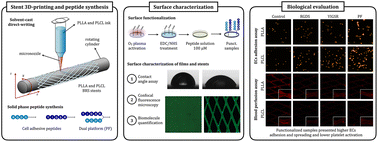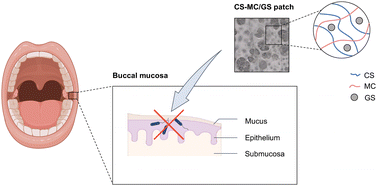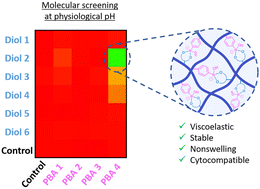Themed collection 32nd Annual Conference of the European Society for Biomaterials, 2022

A dive into the bath: embedded 3D bioprinting of freeform in vitro models
This minireview highlights recent advances on the application of embedded 3D bioprinting concepts for the fabrication of in vitro models.

Biomater. Sci., 2023,11, 5462-5473
https://doi.org/10.1039/D3BM00626C
Renal tissue engineering for regenerative medicine using polymers and hydrogels
The kidney regeneration strategies by tissue engineering using polymers and hydrogels, creating functional cell material scaffolds. AKD (acute kidney disease), CKD (chronic kidney disease), and ESRD (end-stage renal disease). (Created with BioRender).

Biomater. Sci., 2023,11, 5706-5726
https://doi.org/10.1039/D3BM00255A
Low molecular weight poly((D,L)-lactide-co-caprolactone) liquid inks for diluent-free DLP printing of cell culture platforms
A library of low molecular weight biocompatible inks has been developed to be used in DLP printing. The resulting inks present low viscosity and are printable without diluents or solvents, resulting in structures with high shape fidelity.

Biomater. Sci., 2023,11, 5163-5176
https://doi.org/10.1039/D3BM00581J
Fetuin A functionalisation of biodegradable PLLA-co-PEG nonwovens towards enhanced biomineralisation and osteoblastic growth behaviour
Fetuin A functionalisation of biodegradable PLLA-co-PEG nonwovens lead to enhanced biomineralisation and improved cell morphology and spreading in vitro.

Biomater. Sci., 2023,11, 5240-5250
https://doi.org/10.1039/D3BM00141E
Supramolecular presentation of bioinstructive peptides on soft multilayered nanobiomaterials stimulates neurite outgrowth
The supramolecular presentation of bioinstructive peptides on multilayered nanofilms enabled self-assembled nanofibers with high laminin-derived IKVAV epitope density, enhancing neuronal cell adhesion, viability, morphology and neurite outgrowth.

Biomater. Sci., 2023,11, 5012-5024
https://doi.org/10.1039/D3BM00438D
Functionalization of 3D printed polymeric bioresorbable stents with a dual cell-adhesive peptidic platform combining RGDS and YIGSR sequences
The functionalization of 3D-printed poly-L-lactic acid (PLLA) and poly(L-lactic-co-ε-caprolactone) (PLCL) bioresorbable stents has been successfully achieved with linear RGDS and YIGSR peptides, as well as a dual platform containing both motifs within a single biomolecule.

Biomater. Sci., 2023,11, 4602-4615
https://doi.org/10.1039/D3BM00458A
Selenium-incorporated mesoporous silica nanoparticles for osteosarcoma therapy
Se-incorporated MSNs were synthesized by loading SeO32−, doping SeO32−, and incorporating SeNP into MSNs. Se-incorporated MSNs showed GSH/NADPH sensitive Se release, selective OS cell inhibition and ROS induction.

Biomater. Sci., 2023,11, 3828-3839
https://doi.org/10.1039/D2BM02102A
Antiviral functionalization of a polypropylene nonwoven textile structure as a self-decontaminating layer for respiratory masks
The aim of this work was to develop a filtering biocidal polypropylene (PP) nonwoven textile structure to block and inactivate airborne bacteria and viruses.

Biomater. Sci., 2023,11, 3502-3511
https://doi.org/10.1039/D2BM01988D
Fe and C additions decrease the dissolution rate of silicon nitride coatings and are compatible with microglial viability in 3D collagen hydrogels
The possibility of decreasing the dissolution rate of SiN coatings using Fe and C is promising and the released ions were demonstrated to be compatible with microglia viability, in both 2D cultures and 3D collagen hydrogels.

Biomater. Sci., 2023,11, 3144-3158
https://doi.org/10.1039/D2BM02074B
Controlled degradation of polycaprolactone-based micropillar arrays
Herein we demonstrate the fabrication and controlled degradation of arrays of polycaprolactone-based micropillars, achieved through the combination of direct laser writing and nanoimprint lithography.

Biomater. Sci., 2023,11, 3077-3091
https://doi.org/10.1039/D3BM00165B
Mucoadhesive chitosan–methylcellulose oral patches for the treatment of local mouth bacterial infections
Electrophoretic deposition allows obtaining gentamicin-loaded chitosan–methylcellulose patches (CS–MC/GS) with distinctive mucoadhesive and antibacterial characteristics, useful to treat mouth bacterial infections.

Biomater. Sci., 2023,11, 2699-2710
https://doi.org/10.1039/D2BM01540D
A new boronate ester-based crosslinking strategy allows the design of nonswelling and long-term stable dynamic covalent hydrogels
Testing libraries of phenylboronic acid derivatives and diols revealed a new crosslinking couple for the formation of viscoelastic hydrogels with tunable properties and long-term stability.

Biomater. Sci., 2023,11, 2033-2045
https://doi.org/10.1039/D2BM01690G
Unravelling the interactions of biodegradable dendritic nucleic acid carriers and neural cells
Our fully biodegradable dendritic nanosystem proved to be biocompatible and mediated fast cellular internalization in neuronal cell lines and cortical neurons, showing great potential as a nucleic acid delivery vector for nervous system applications.

Biomater. Sci., 2023,11, 1499-1516
https://doi.org/10.1039/D2BM01114J
PDAC-on-chip for in vitro modeling of stromal and pancreatic cancer cell crosstalk
Schematic representation of PDAC-on-chip reassembly the pancreatic acino-ductal unit composed of healthy and pathological human pancreatic ductal epithelial cells (HPDE and KRAS-HPDE, respectively) surrounded by pancreatic stellate cells (PSCs).

Biomater. Sci., 2023,11, 208-224
https://doi.org/10.1039/D2BM00881E
Elastomeric, bioadhesive and pH-responsive amphiphilic copolymers based on direct crosslinking of poly(glycerol sebacate)-co-polyethylene glycol
Novel PGS-co-PEG elastomers showed multifunctional characteristics such as high swelling, flexibility, bioadhesiveness and biocompatibility, and good biodegradation, mechanical properties and pH-responsive behaviour.

Biomater. Sci., 2022,10, 7015-7031
https://doi.org/10.1039/D2BM01335E
About this collection
This collection showcases some of the research that was presented at the 32nd Annual Meeting of the European Society for Biomaterials in September 2022. As the official journal of the European Society for Biomaterials (ESB), Biomaterials Science works in partnership with the European Society for Biomaterials to highlight some of the top research from the community on the theme of driving the development of innovative solutions for clinical applications. We hope you enjoy reading this collection of featured research.